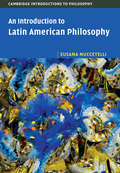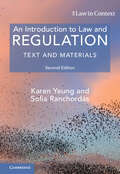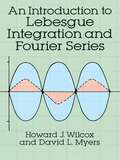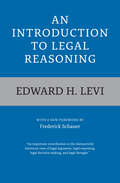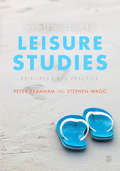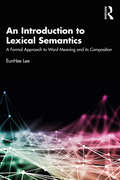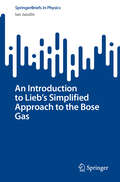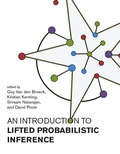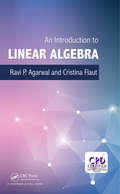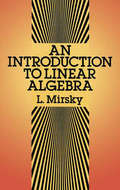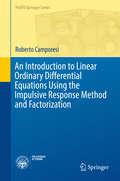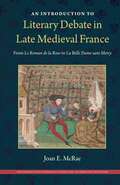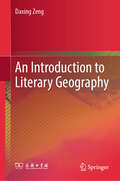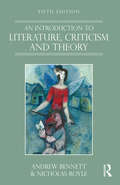- Table View
- List View
An Introduction to Latin American Economics: Understanding Theory Through History
by Scott McKinneyThis textbook serves as an introduction to the major economic topics and events in Latin America’s history, from the settling of the region by indigenous Americans and then Europeans, Africans and Asians, to the economic consequences of COVID-19. Each chapter concentrates on a particular period—for example, pre-Columbian America, the 1980s debt crisis, the 21st Century decline in income inequality—and introduces the concepts needed to understand the events of that period. These concepts include theories such as Dutch Disease and Dependency Theory, policies such as import-substituting industrialization and neoliberalism, and analytical tools such as the circular flow of income and the foreign exchange market. Descriptive data are used to illustrate these concepts: for example, Latin America’s current account balance during the 1970s and 1980s shows the impact of the debt crisis, while the relationship between money supply growth and inflation in Argentina during the 1980s and 1990s shows the impact of expansionary monetary policy and convertibility.With its focus on Latin American economic history and on the key concepts for understanding that history, this book can serve as the core textbook for an introductory course on Latin American Economics, or as a complementary text for an introductory course in Latin American Studies or a social science course on Latin America.
An Introduction to Latin American Philosophy (Cambridge Introductions to Philosophy)
by Susana NuccetelliLatin American philosophy is best understood as a type of applied philosophy devoted to issues related to the culture and politics of Latin America. This introduction provides a comprehensive overview of its central topics. It explores not only the unique insights offered by Latin American thinkers into the traditional pre-established fields of Western philosophy, but also the many 'isms' developed as a direct result of Latin American thought. Many concern matters of practical ethics and social and political philosophy, such as Lascasianism, Arielism, Bolívarism, modest and immodest feminisms, republicanism, positivism, Marxism, and liberationism. But there are also meta-philosophical 'isms' such as originalism and perspectivism. Together with clear and accessible discussions of the major issues and arguments, the book offers helpful summaries, suggestions for further reading, and a glossary of terms. It will be valuable for all readers wanting to explore the richness and diversity of Latin American philosophy.
An Introduction to Law
by Phil HarrisNesta's life is thrown into upheaval when she gets involved in charity work thinking that it might be a cool way to meet people (mainly boys). But as her eyes are opened to the plight of the world, she begins to genuinely want to get involved and help others. On top of this, Nesta meets William, a boy who questions her motives. At times, she's convinced he hates her and the feeling is mutual. But Izzie, Lucy and T. J. think it is something more like love.
An Introduction to Law and Regulation: Text and Materials (Law in Context)
by Karen Yeung Sofia RanchordásContemporary life relies on regulation. The quality and safety of the water we drink, the food we eat, and the social media applications we use are all governed by multiple regulatory regimes. Although rooted in law, regulation is a multidisciplinary endeavour. Debates about regulation, particularly in the face of rapid change and the emergence of new 'risks', are now commonplace. Despite extensive scholarship, regulation is often poorly understood, even by policy-makers, with unintended and even disastrous consequences. This book offers a critical introduction to core theories, concepts, methods, tools, and techniques of regulation, including regulatory policy, instruments, enforcement, compliance, accountability and legitimacy. Weaving extracts from texts drawn from many disciplines with accessible commentary, it introduces this important field to students, scholars, and practitioners in a scholarly yet accessible and engaging manner with discussion questions and additional readings for those seeking to deepen their knowledge.
An Introduction to Lebesgue Integration and Fourier Series (Dover Books on Mathematics)
by David L. Myers Howard J. WilcoxThis book arose out of the authors' desire to present Lebesgue integration and Fourier series on an undergraduate level, since most undergraduate texts do not cover this material or do so in a cursory way. The result is a clear, concise, well-organized introduction to such topics as the Riemann integral, measurable sets, properties of measurable sets, measurable functions, the Lebesgue integral, convergence and the Lebesgue integral, pointwise convergence of Fourier series and other subjects.The authors not only cover these topics in a useful and thorough way, they have taken pains to motivate the student by keeping the goals of the theory always in sight, justifying each step of the development in terms of those goals. In addition, whenever possible, new concepts are related to concepts already in the student's repertoire.Finally, to enable readers to test their grasp of the material, the text is supplemented by numerous examples and exercises. Mathematics students as well as students of engineering and science will find here a superb treatment, carefully thought out and well presented , that is ideal for a one semester course. The only prerequisite is a basic knowledge of advanced calculus, including the notions of compactness, continuity, uniform convergence and Riemann integration.
An Introduction to Legal Reasoning
by Edward H. LeviThis volume will be of interest and value to students of logic, ethics, and political philosophy, as well as to members of the legal profession and to everyone concerned with problems of government and jurisprudence. By citing a large number of cases, the author makes his presentation of the processes of judicial interpretation particularly lucid.
An Introduction to Leisure Studies: Principles and Practice
by Stephen Wagg Dr Peter Bramham"There are textbooks galore, but there aren't many crafted as intelligently as this one. This book will change the way that students understand leisure. It will give them an easier entry to that place where difficult ideas fuse into something intelligible, where real understanding sits and the educated imagination is stirred." - Tony Blackshaw, Sheffield Hallam University Peter Bramham and Stephen Wagg provide a foundation for those studying within the broad field of leisure studies. The book gives students an accessible and engaging introduction to leisure studies and leisure research, encouraging students to engage in reflexive analysis of their common sense understandings of everyday life and enabling them to develop an understanding of contemporary leisure studies and changing leisure practices.
An Introduction to Lexical Semantics: A Formal Approach to Word Meaning and its Composition
by EunHee LeeAn Introduction to Lexical Semantics provides a comprehensive theoretical overview of lexical semantics, analysing the major lexical categories in English: verbs, nouns, adjectives, adverbs and prepositions. The book illustrates step-by-step how to use formal semantic tools. Divided into four parts, covering the key aspects of lexical semantics, this book: introduces readers to the major influential theories including the syntax-lexical semantics interface theory by Levin and Rappaport and Pinker, the generative lexicon theory by Pustejovsky and formal semantic analyses discusses key topics in formal semantics including metonymy, metaphor and polysemy illustrates how to study word meaning scientifically by discussing mathematical notions applied to compositional semantics. Including reflection questions, summaries, further reading and practice exercises for each chapter, this accessible guide to lexical semantics is essential reading for advanced students and teachers of formal semantics.
An Introduction to Lieb's Simplified Approach to the Bose Gas (SpringerBriefs in Physics)
by Ian JauslinThis book explores Lieb's Simplified approach to the ground state of systems of interacting bosons. While extensive research has delved into the behavior of interacting bosons, persistent challenges, such as proving Bose-Einstein condensation, remain. Introduced by Lieb in 1963, the Simplified approach has been the object of renewed attention in recent years, revealing surprising and promising results. Notably, this approach provides ground state energy predictions that agree with many-body systems asymptotically at both low and high densities. It further predicts a condensate fraction and correlation function that agree with Bogolyubov theory at low densities, and numerical predictions match quantum Monte Carlo simulations across all densities. This suggests that Lieb's Simplified approach could serve as a potent tool for reimagining the study of interacting bosons. The book defines Lieb's Simplified approach, discusses its predictions, and presents known analytical and numerical results. It is designed for advanced students and young researchers working in the fields of mathematical physics, quantum many-body physics and Bose-Einstein condensates.
An Introduction to Life-Course Criminology
by Jerzy Sarnecki Christoffer CarlssonMost people engage in crime at some point in their lives, but why does almost everybody stop soon after? And, why do a small number of offenders persist in crime? These two questions constitute the core of the field often known as life-course criminology. This book provides a comprehensive introduction to life-course criminology. It covers the dominant theories and methodologies in the field and equips you with all you need to succeed in your studies on the subject. The book: Discusses the methodologies of life-course and longitudinal research Explains and critiques the major theories of life-course criminology Considers the issues of risk, prediction, onset, persistence and desistance of criminal activity Draws on research from studies in Europe, the UK, US and Australia, including the Stockholm Life-Course Project Written by two leading figures in the field, this is an authoritative text that will guide you through your studies in life-course criminology, criminal career research, and developmental criminology.
An Introduction to Life-Course Criminology
by Jerzy Sarnecki Christoffer CarlssonMost people engage in crime at some point in their lives, but why does almost everybody stop soon after? And, why do a small number of offenders persist in crime? These two questions constitute the core of the field often known as life-course criminology. This book provides a comprehensive introduction to life-course criminology. It covers the dominant theories and methodologies in the field and equips you with all you need to succeed in your studies on the subject. The book: Discusses the methodologies of life-course and longitudinal research Explains and critiques the major theories of life-course criminology Considers the issues of risk, prediction, onset, persistence and desistance of criminal activity Draws on research from studies in Europe, the UK, US and Australia, including the Stockholm Life-Course Project Written by two leading figures in the field, this is an authoritative text that will guide you through your studies in life-course criminology, criminal career research, and developmental criminology.
An Introduction to Lifted Probabilistic Inference (Neural Information Processing series)
by David PooleRecent advances in the area of lifted inference, which exploits the structure inherent in relational probabilistic models.Statistical relational AI (StaRAI) studies the integration of reasoning under uncertainty with reasoning about individuals and relations. The representations used are often called relational probabilistic models. Lifted inference is about how to exploit the structure inherent in relational probabilistic models, either in the way they are expressed or by extracting structure from observations. This book covers recent significant advances in the area of lifted inference, providing a unifying introduction to this very active field. After providing necessary background on probabilistic graphical models, relational probabilistic models, and learning inside these models, the book turns to lifted inference, first covering exact inference and then approximate inference. In addition, the book considers the theory of liftability and acting in relational domains, which allows the connection of learning and reasoning in relational domains.
An Introduction to Lightning
by Vernon CoorayThis book about lightning summarizes the essence of physics and effects of lightning in a non-technical manner and provides an up-to-date description of the phenomenon of lightning in simple language. Starting with the myths related to lightning, the reader is introduced to the mechanism of lightning flashes and their interactions with humans, human-made systems and Earth's environment. Most of the available books on lightning are written for the experts in the field and there is a need for a book that introduces the undergraduate and beginning post graduate students to the subject of lightning and prepares them for more advanced books meant for the experts. This introductory book, which is based on a series of lectures given to undergraduate and postgraduate students in electrical engineering, is intended to fill this need. Tailored to the needs of university students who plan to study electrical engineering, meteorology, environmental or basic physics, it is also a valuable reference resource for laymen who are interested in knowing more on this phenomenon.
An Introduction to Linear Algebra
by Ravi P. Agarwal Elena Cristina FlautThe techniques of linear algebra are used extensively across the applied sciences, and in many different areas of algebra such as group theory, module theory, representation theory, ring theory, and Galois theory. Written by experienced researchers with a decades of teaching experience, Introduction to Linear Algebra is a clear and rigorous introductory text on this key topic for students of both applied sciences and pure mathematics.
An Introduction to Linear Algebra (Dover Books on Mathematics)
by L. MirskyThis work provides an elementary and easily readable account of linear algebra, in which the exposition is sufficiently simple to make it equally useful to readers whose principal interests lie in the fields of physics or technology. The account is self-contained, and the reader is not assumed to have any previous knowledge of linear algebra. Although its accessibility makes it suitable for non-mathematicians, Professor Mirsky's book is nevertheless a systematic and rigorous development of the subject. Part I deals with determinants, vector spaces, matrices, linear equations, and the representation of linear operators by matrices. Part II begins with the introduction of the characteristic equation and goes on to discuss unitary matrices, linear groups, functions of matrices, and diagonal and triangular canonical forms. Part II is concerned with quadratic forms and related concepts. Applications to geometry are stressed throughout; and such topics as rotation, reduction of quadrics to principal axes, and classification of quadrics are treated in some detail. An account of most of the elementary inequalities arising in the theory of matrices is also included. Among the most valuable features of the book are the numerous examples and problems at the end of each chapter, carefully selected to clarify points made in the text.
An Introduction to Linear Algebra and Tensors (Dover Books on Mathematics)
by Richard A. Silverman M. A. Akivis V. V. GoldbergThe present book, a valuable addition to the English-language literature on linear algebra and tensors, constitutes a lucid, eminently readable and completely elementary introduction to this field of mathematics. A special merit of the book is its free use of tensor notation, in particular the Einstein summation convention. The treatment is virtually self-contained. In fact, the mathematical background assumed on the part of the reader hardly exceeds a smattering of calculus and a casual acquaintance with determinants.The authors begin with linear spaces, starting with basic concepts and ending with topics in analytic geometry. They then treat multilinear forms and tensors (linear and bilinear forms, general definition of a tensor, algebraic operations on tensors, symmetric and antisymmetric tensors, etc.), and linear transformation (again basic concepts, the matrix and multiplication of linear transformations, inverse transformations and matrices, groups and subgroups, etc.). The last chapter deals with further topics in the field: eigenvectors and eigenvalues, matrix ploynomials and the Hamilton-Cayley theorem, reduction of a quadratic form to canonical form, representation of a nonsingular transformation, and more. Each individual section -- there are 25 in all -- contains a problem set, making a total of over 250 problems, all carefully selected and matched. Hints and answers to most of the problems can be found at the end of the book.Dr. Silverman has revised the text and numerous pedagogical and mathematical improvements, and restyled the language so that it is even more readable. With its clear exposition, many relevant and interesting problems, ample illustrations, index and bibliography, this book will be useful in the classroom or for self-study as an excellent introduction to the important subjects of linear algebra and tensors.
An Introduction to Linear Ordinary Differential Equations Using the Impulsive Response Method and Factorization (PoliTO Springer Series)
by Roberto CamporesiThis book presents a method for solving linear ordinary differential equations based on the factorization of the differential operator. The approach for the case of constant coefficients is elementary, and only requires a basic knowledge of calculus and linear algebra. In particular, the book avoids the use of distribution theory, as well as the other more advanced approaches: Laplace transform, linear systems, the general theory of linear equations with variable coefficients and variation of parameters. The case of variable coefficients is addressed using Mammana's result for the factorization of a real linear ordinary differential operator into a product of first-order (complex) factors, as well as a recent generalization of this result to the case of complex-valued coefficients.
An Introduction to Linear and Nonlinear Scattering Theory (Monographs And Surveys In Pure And Applied Math #78)
by G F RoachThis monograph has two main purposes, first to act as a companion volume to more advanced texts by gathering together the principal mathematical topics commonly used in developing scattering theories and, in so doing, provide a reasonable, self-contained introduction to linear and nonlinear scattering theory for those who might wish to begin working in the area. Secondly, to indicate how these various aspects might be applied to problems in mathematical physics and the applied sciences. Of particular interest will be the influence of boundary conditions.
An Introduction to Linguistics through Popular Music
by Patrice LarroqueThis textbook introduces the field of linguistics, demonstrating syntactic categories, morphological structures, phonological/metric structures, syllable structures, and varieties of English in an accessible way by using portions of song lyrics from popular music. The varieties of English covered include Received Pronunciation (RP) and General American, as well as some features of Australian English, southern US varieties, and Scottish English. Drawing on shared characteristics between language and music, including metrical structure, the author suggests a different approach to linguistic analysis and the description of spoken language. The book introduces both students and instructors to a novel and engaging method of description, and provides a fresh vocabulary with which to start thinking about language. It demonstrates complex topics by using music as a fun and familiar starting point, and will be an ideal resource for introductory linguistics courses worldwide.
An Introduction to Literary Debate in Late Medieval France: From Le Roman de la Rose to La Belle Dame sans Mercy (New Perspectives on Medieval Literature: Authors and Traditions)
by Joan E. McRaeHow medieval poems sparked discussions on women’s agency, love, marriage, and honor that prefigured modern feminism This volume immerses readers in a debate tradition that flourished in France during the late Middle Ages, focusing on two works that were both popular and controversial in their time: Le Roman de la Rose by thirteenth-century poets Guillaume de Lorris and Jean de Meun and La Belle Dame sans Mercy by fifteenth-century royal secretary and poet Alain Chartier. This is the first comparative volume on these important works and the discussions they sparked. Engaging with questions of women’s agency, love, marriage, and honor, these two poems prompted responses that circulated via treatises, letters, and sermons among officials, clerics, and poets. Joan McRae provides commentary on the two texts, a timeline and summary of the resulting debates, and biographical sketches of the leading intellectuals who matched wits over different ways of reading the texts, including pioneering writer Christine de Pizan. McRae shows that these works and the debates, read together, consider a range of social issues that raise questions of gender, the place of power and hierarchy in societal relationships, and the responsibility of writers for the effect of their works on readers. An Introduction to Literary Debate in Late Medieval France is a helpful overview of these weighty arguments for both students and scholars. McRae provides a compact, comprehensive, and up-to-date study, spotlighting influential literary expressions that evolved into the “querelle des femmes,” the “woman question,” which in turn paved the way for modern feminism. A volume in the series New Perspectives on Medieval Literature: Authors and Traditions, edited by R. Barton Palmer and Tison Pugh
An Introduction to Literary Geography
by Daxing ZengThis book, the first introductory work of Literary Geography Studies in China, justifies literary geography as a discipline running in parallel with literary theory, literary criticism, and literary history. Zeng argues that Literary Geography Studies is a subdiscipline of literary studies rather than an interdisciplinary field or a subfield of geography. Zeng believes that, in Literary Geography Studies, the theories and methodologies of geography are adopted to solve problems in literary studies rather than problems in geography. The book has, for the first time, set up a theoretical framework for Literary Geography Studies as a secondary discipline. It has consequently structured the disciplinary knowledge covering topics such as the research object, research methodology, geographical influence upon literary production, geographical distribution of writers, geographical space in literary works, literary landscapes, literary regionality, and critical literary geography. This framework will bean invaluable tool to future scholars of Literary Geography Studies as it provides a systematic and detailed overview of the field, something that is currently lacking in English-language publications. In addition, the book derives its philosophy from ancient Chinese culture and establishes an innovative theoretical framework for Literary Geography Studies based on abundant examples from ancient Chinese literature, thus making a significant contribution to the existing literary studies by increasing a geo-spatial understanding of ancient Chinese literature.
An Introduction to Literary Studies
by Mario KlarerThe fourth edition of this classic beginner’s guide to literary studies has been fully updated throughout. Mario Klarer offers a concise and accessible discussion of central issues in English and world literature as well as film and television series. Starting with the basics of what constitutes a literary text, the book moves through an analysis of major genres, important periods, and key theoretical approaches to literature and film. It also looks at the practicalities of finding and referencing secondary sources when writing a research paper. The expanded new edition has been updated to include: a wider range of examples from world literature, cinema, and television series additional references to contemporary streaming formats updated chapters on postcolonial theory, cultural studies, gender theory, feminism, and queer theory new sections on digital humanities, ecocriticism, literary translations, and paratexts extended explanations of traditional genres, e.g., the epic, drama, and poetry a completely revised chapter on the most recent MLA guidelines with rules for citing new media formats The detailed glossary ensures that the book is accessible to readers of any level, making this an ideal self-study guide or a course book for Introduction to Literature classes.
An Introduction to Literary Studies
by Mario KlarerIn this classic beginner's guide to English literature, Mario Klarer offers a concise and accessible discussion of central issues in the study of literary texts, looking at: definitions of key terms such as literature and text the genres of fiction, poetry, drama, and film periods and classifications of literature theoretical approaches to texts the use of secondary resources guidelines for writing research essays The new and expanded edition is fully updated to include: a wider range of textual examples from world literature additional references to contemporary cinema, a section on comparative literature an extended survey of literary periods and genres recent changes in MLA guidelines information on state-of-the-art citation management software the use and abuse of online resources. The book also features suggestions for further reading as well as an extensive glossary of key terms.
An Introduction to Literature and the Fine Arts
by The Editors at Michigan State College PressA collaborative study of the arts of literature, music, sculpture, architecture, and painting in the development of the Western tradition.
An Introduction to Literature, Criticism and Theory
by Andrew Bennett Nicholas RoyleLively, original and highly readable, An Introduction to Literature, Criticism and Theory is the essential guide to literary studies. Starting at ‘The Beginning’ and concluding with ‘The End’, chapters range from the familiar, such as ‘Character’, ‘Narrative’ and ‘The Author’, to the more unusual, such as ‘Secrets’, ‘Pleasure’ and ‘Ghosts’. Now in its fifth edition, Bennett and Royle’s classic textbook successfully illuminates complex ideas by engaging directly with literary works, so that a reading of Jane Eyre opens up ways of thinking about racial difference, for example, while Chaucer, Raymond Chandler and Monty Python are all invoked in a discussion of literature and laughter. The fifth edition has been revised throughout and includes four new chapters – ‘Feelings’, ‘Wounds’, ‘Body’ and ‘Love’ – to incorporate exciting recent developments in literary studies. In addition to further reading sections at the end of each chapter, the book contains a comprehensive bibliography and a glossary of key literary terms. A breath of fresh air in a field that can often seem dry and dauntingly theoretical, this book will open the reader’s eyes to the exhilarating possibilities of reading and studying literature.

